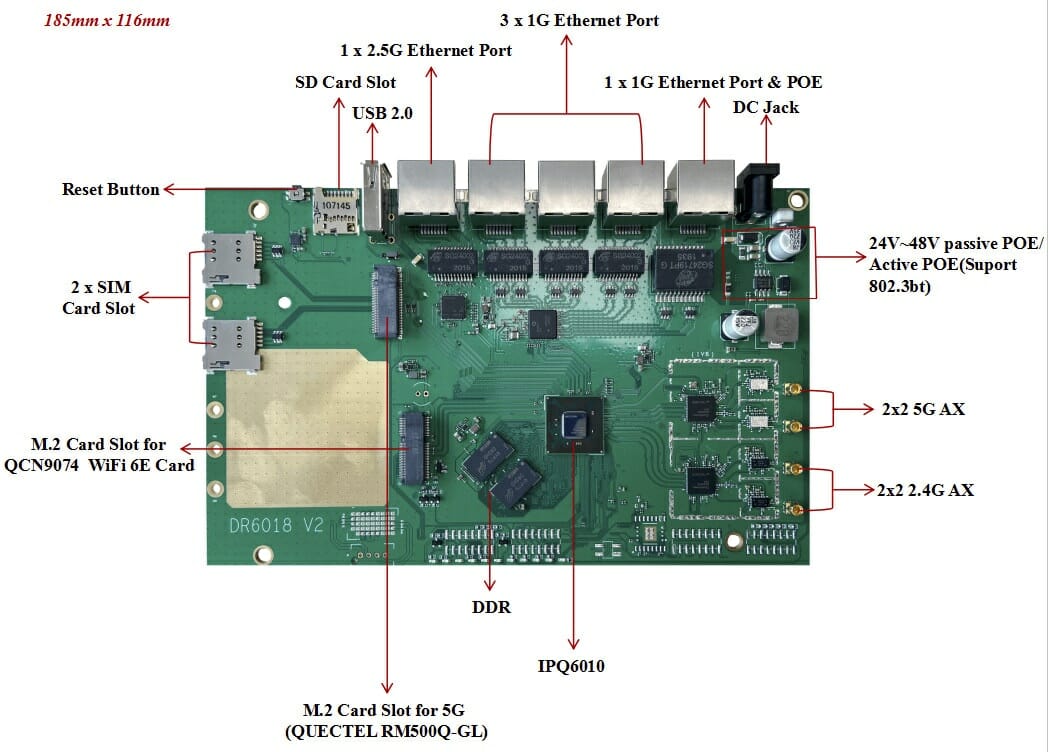A few months ago we covered DR6018 (aka CP01) WiFi 6 Embedded SBC powered by Qualcomm IPQ6018 processor and offering six Ethernet ports including five Gigabit interfaces and one 2.5 Gbps Ethernet port.
Wallys Communications has now informed CNX Software they had a new version of the board called DR6018 V2 with a more compact form factor, support for PoE, as well as optional WiFi 6E and 5G IoT M.2 modules.

DR6018 V2 board specifications:
- SoC – Qualcomm Atheros IPQ6010 quad-core Arm Cortex-A53 processor @ 1.8 GHz
- System Memory – 1GB (2x 512MB) DDR3L 16-bit interface with 32-bit memory bus design
- Storage – 256MB NAND Flash, 32MB NOR flash, SD card slot
- Networking
- Wired
- 3x Gigabit Ethernet ports (one less compared to DR6018)
- 1x Gigabit Ethernet port with PoE support
- 1x 2.5Gbps Ethernet port
- Wireless
- WiFi
- 2×2 2.4GHz MU-MIMO OFDMA 802.11b/g/n/ax WiFi 6, max 23dBm per chain
- 2×2 5GHz MU-MIMO OFDMA 802.11a/n/ac/ax WiFi 6, max 20dBm per chain
- 4x MMCX connectors
- 2.4 GHz data rate up to 573 Mbps
- 5 GHz data rate up to 1201 Mbps
- CSR8811 Bluetooth 4.2 LE module
- WiFi
- Optional Wireless Expansion
- Quectel RM500Q-GL M.2 card + 2x SIM card sockets for 5G cellular IoT/eMBB applications. Supports both 5G NSA and SA modes, fallback to 4G LTE and 3G, as well as GPS, GLONASS, BeiDou, and Galileo GNSS.
- Qualcomm QCN9074 WiFi 6E card with 4×4 MIMO 802.11ax connectivity providing a larger spectrum (5.925 – 7.125 GHz) and higher data transfer rates up to 4949 Mbps
- Wired
- USB – 1x USB 3.0 Type-C port, USB 2.0 Type-A port
- Expansion – 2x M.2 (NGFF) “E Key” socket with MiniPCIe 3.0
- Serial – 12-pin header for serial connection.
- Misc – Reset button, FFC/FPC Connector for LED
- Power Supply
- 12VDC via DC jack input
- 24V~48V passive or active PoE (802.3bt)
- Dimensions – 185 x 116 mm
- Temperature Range – Operating: -40 to +70°C; storage: -40 to +105°C
The company informed us the switch from IPQ6018 to IPQ6010 was because both processors are basically the same except for AI functions on IPQ6018 SoC.
The board supports OpenWrt 14.07 Barrier Breaker firmware and Qualcomm SDK with QCA binary drivers. The company explains the board is suitable for 802.11ax MU-MIMO OFDMA access point, EasyMesh mesh router supporting EasyMesh, and Smart access points with TWT (Target Wake Time) to extend the battery life of clients. But considering the addition of 5G and WiFi 6E, the embedded board looks like a good candidate for advanced IoT gateways, Fixed Wireless Access (FWA) routers, and 5G Mobile hotspots.
DR6018 V2 samples are available now for around $200. The WiFi 6E card can be found for around $250 and the 5G IoT module for just under $500. Further information may be found on the product page.

Jean-Luc started CNX Software in 2010 as a part-time endeavor, before quitting his job as a software engineering manager, and starting to write daily news, and reviews full time later in 2011.
Support CNX Software! Donate via cryptocurrencies, become a Patron on Patreon, or purchase goods on Amazon or Aliexpress





Why a 6 years old openwrt? Probably because routers are never in an exposed position in a network, where hacking never occurs? Or because backporting security fixes is such a fun job to do?
I wonder whether this has two or three network interfaces (the three gigabit ones are in the same switch)?
If you look at the PCB picture, you can see the routing of all but the 2.5Gbps port goes via the switch.
Yeah, you only get WiFi 6E if you populate the M.2 slot with an optional Qualcomm Atheros QCN9074 4×4 MU-MIMO 6GHz WiFi 6E Radio Module – and as you discovered those cost another $249. Here’s another source for the module (still $249):
https://www.shop.compex.com.sg/product-page/pn02-7
The QCN9074 M.2 card has 4x U.FL connectors on it for external 6GHz WiFi 6E(xtended) antennas, which are another form of WiFi 6E unobtanium (see below). Also, is it even legal to use WiFi 6E yet? I thought the repack of the C-Band Fixed Satellite Service (FSS) band had to be finished first to free-up spectrum? Or maybe that’s for some other service, like cellular? On second thought WiFi 6E covers 5925-7125 MHz (or 6105-7125 MHz) and the standard (not extended) C-band FSS covers 5850-6425 MHz for Earth to satellite uplinks. So I don’t think the two services will bother each other.
BTW, here’s a tri-band Wifi antenna I found that covers the WiFi 6E segment:
https://www.te.com/usa-en/about-te/news-center/te-antennas-for-wi-fi-6e.html
That antenna covers 2400-2483.5 MHz, 5150-5875 MHz and 5925-7125 MHz through one connector. The QCN9074 WIFI 6E M.2 card supports 2.4GHz, 5GHz and 6GHz for WiFi 6E (WiFi 6E is just 2.4GHz + 5GHz WiFi 6 plus the added 6GHz RF band). So I think the on-board 2.4GHz + 5GHz radios on the router itself will need to be disabled some how when the QCN9074 WIFI 6E module is used; which makes me wonder why the router board costs so much. Maybe there’s an expensive license needed to let you touch the Qualcomm Atheros SDK IP and binary blobs that come with the router.
Soooo what you’re telling me is…
For the low-low price of ~$950 + ~$450 of weBoost RV Antennas + coax, mounting brackets, 3D printed case/mounting, cooling heat sinks, fan, etc. I could have the most bulletproof mobile internet on the planet?
Complete with a pair of ~$80 data plans from T-Mobile (Magenta Max) for true unlimited, and Verizon (Play More) for dead zone fallback?
~$1500 + $2K yrly well spent!